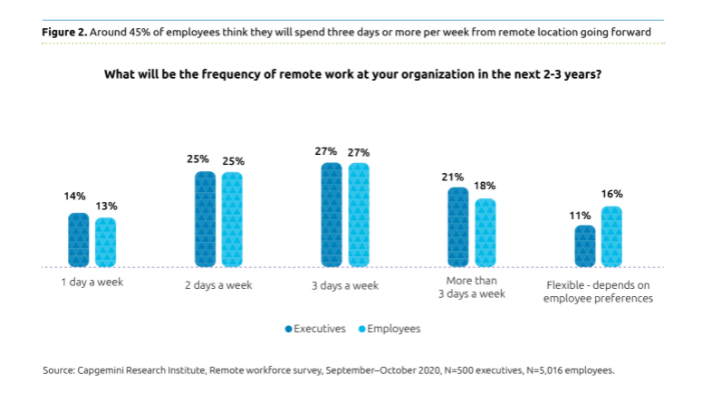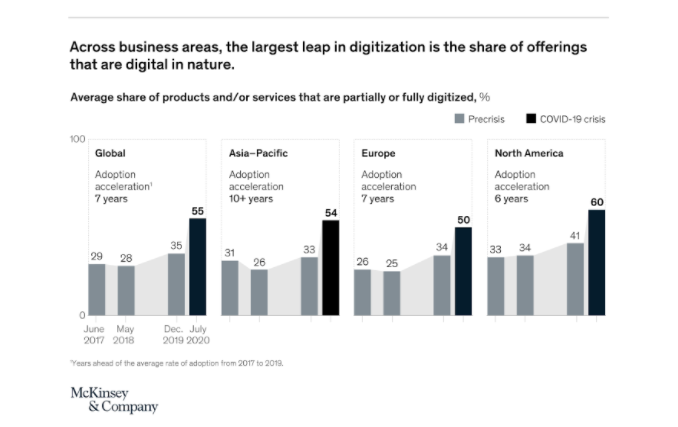The Office: From remote to hybrid
Remote working has become the new normal for many of us since 2020. The transition to remote working - which is normally would have taken years - happened at lightning speed. Office buildings suddenly became vacant and companies underwent a digital transformation. In the meantime, it seems that society is slowly coming out of its isolation and more people may be able to go to the office again. Therefore, as far as we are concerned, this is a good time to reflect. What lessons can we learn from the remote working transition?
Remote is here to stay
What is immediately striking is that business productivity need not be jeopardised by remote working. Research by PwC shows that many executives perceive an increase in productivity in the last quarter of 2020. If colleagues can't come and stand next to your desk during the working day to 'tune things up', you're obviously a lot more efficient. In addition, this PwC study shows that the positive attitude towards remote working among managers is increasing. In the second quarter of 2020, 73% of those surveyed indicated that the transition to remote working had been successful. In the last quarter of 2020, this percentage had even risen to 83%.
From Research by Capgemini shows that nearly 70% of organisations expect the productivity gains from working remotely to be sustainable after the pandemic. The same study shows that executives believe that employees in various positions will work an average of 2.4 days per week at remote locations in the post-pandemic world. This is almost a 70% increase, compared to 1.4 days before the pandemic. These figures indicate that the pandemic has made many executives realise that the office does not have to be a requirement for ensuring employee productivity.
So if these studies are to be believed, remote working will become a permanent part of the way we work in the post-pandemic world. Yet many executives still see the importance of the office. The Research by PwC shows that 68% of the surveyed executives believe that employees should be in the office at least three days a week to maintain a distinctive company culture. In addition, more than half of the surveyed executives believe that the office is important for the mutual cooperation between colleagues.
Digital is here to stay
Another consequence of the forced transition to remote working is that the use of technology has become even more important to keep the organisation running. In just a few months, the COVID-19 pandemic has led to changes - in the way companies work - that would otherwise have taken years. According to one McKinsey Global Survey companies have accelerated the share of digital products in their portfolios by a shocking seven years by 2020. From this we can conclude that digital tools were necessary to achieve the transition to remote working. Technology has shown that it can help companies to operate more flexibly and at the same time drive business growth.
However, we also know that only the acquisition and implementation of new technologies not enough is not enough. Success depends on the effective use of the technology. Among other things, it is important that employees have the right mindset and skills, otherwise the obligatory cooperation with technology will create tensions.
From remote to hybrid
The full remote working model we have seen in 2020 has had mixed results. While it may offer benefits to organisations and some groups of employees, the full remote working model also has negative implications for many employees. Moreover, many managers and employees also see the importance of the office. As a result, the choice for a hybrid model - which strikes a balance between remote work and office models - seems very plausible for many organisations. Whether this is 2.4 days a week at home or 3 days at the office.
Steelcase surveyed executives about this hybrid form of work and their report shows that more and more executives are seeing the potential. At the start of the pandemic, many managers saw no need to change their policies, but now 87% of executives worldwide say they expect to offer more flexibility over where, when and how people work. That's a 38% increase from April 2020. More companies in more countries are expanding flexible work policies. For example announced Unilever's CEO in January 2021 already said his employees will never go to the office five days a week again. And we're also seeing many of our partners embrace the hybrid form of working.
Fortunately, many employees are enthusiastic about hybrid working, as are many managers. Research by McKinsey shows that more than half of the employees are in favour of more flexibility about where, when and how they can work. Unfortunately, COVID-19 has brought with it a lot of trouble, but how nice it would be if hybrid working became the norm for many in the post-pandemic world.
Are you ready to Unfurl?
As employees gain more flexibility over where they work, technology will play a major role in their collaboration. Curious about what technology can do for your company and your employees? We would be happy to answer your questions over a (virtual) cup of coffee or tea. Entirely free of obligation, of course.
Want to read more first? In our next blog we will show you a very practical and effective model to bring the forces of technology and people together in the post-pandemic workplace. Do you want to be the first to receive this blog? Press the 'Let's Unfurl' button and we will personally make sure you receive it in your mailbox first.




